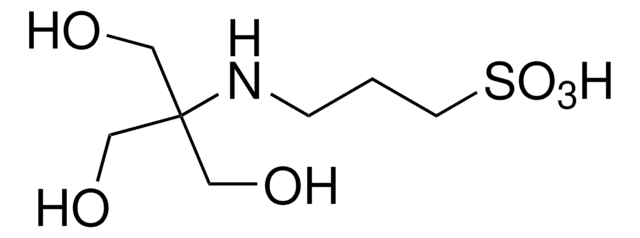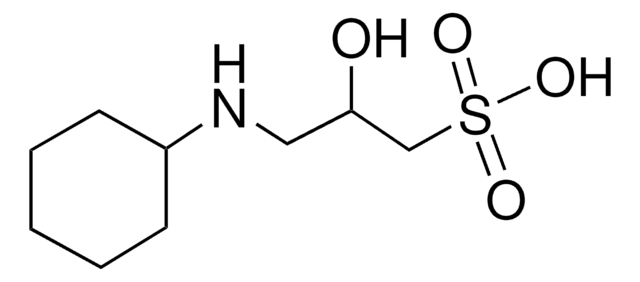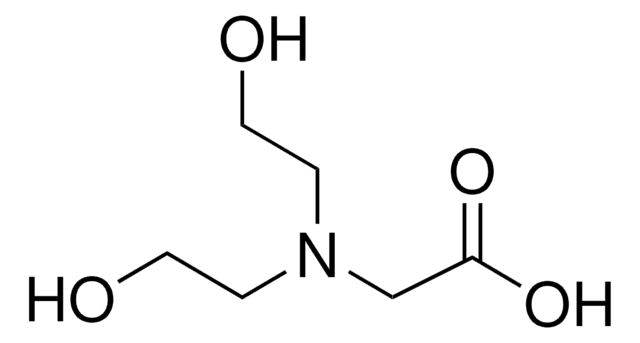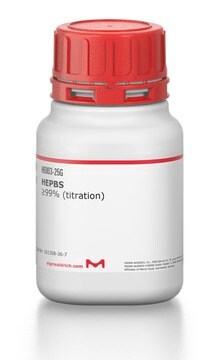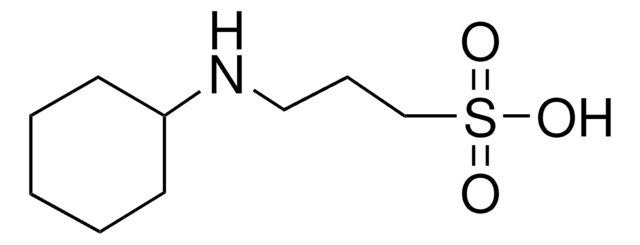T9659
TAPS
BioXtra, ≥99.5% (titration)
Synonyme(s) :
N-[Tris(hydroxymethyl)methyl]-3-aminopropanesulfonic acid, [(2-Hydroxy-1,1-bis(hydroxymethyl)ethyl)amino]-1-propanesulfonic acid
About This Item
Produits recommandés
Gamme de produits
BioXtra
Essai
≥99.5% (titration)
Forme
powder
Impuretés
≤0.005% Phosphorus (P)
≤0.1% Insoluble matter
Résidus de calcination
≤0.1%
Plage de pH utile
7.7-9.1
pKa
8.4
Pf
230-235 °C (dec.)
Solubilité
H2O: 1 M, clear, colorless
Traces d'anions
chloride (Cl-): ≤0.05%
Traces de cations
Al: ≤0.0005%
Ca: ≤0.001%
Cu: ≤0.0005%
Fe: ≤0.0005%
K: ≤0.005%
Mg: ≤0.0005%
NH4+: ≤0.05%
Na: ≤0.005%
Pb: ≤0.001%
Zn: ≤0.0005%
Absorption
≤0.05 at 260 in H2O at 1 M
≤0.05 at 280 in H2O at 1 M
Application(s)
diagnostic assay manufacturing
Chaîne SMILES
OCC(CO)(CO)NCCCS(O)(=O)=O
InChI
1S/C7H17NO6S/c9-4-7(5-10,6-11)8-2-1-3-15(12,13)14/h8-11H,1-6H2,(H,12,13,14)
Clé InChI
YNLCVAQJIKOXER-UHFFFAOYSA-N
Vous recherchez des produits similaires ? Visite Guide de comparaison des produits
Code de la classe de stockage
11 - Combustible Solids
Classe de danger pour l'eau (WGK)
WGK 3
Point d'éclair (°F)
>230.0 °F - closed cup
Point d'éclair (°C)
> 110 °C - closed cup
Équipement de protection individuelle
Eyeshields, Gloves, type N95 (US)
Faites votre choix parmi les versions les plus récentes :
Déjà en possession de ce produit ?
Retrouvez la documentation relative aux produits que vous avez récemment achetés dans la Bibliothèque de documents.
Les clients ont également consulté
Notre équipe de scientifiques dispose d'une expérience dans tous les secteurs de la recherche, notamment en sciences de la vie, science des matériaux, synthèse chimique, chromatographie, analyse et dans de nombreux autres domaines..
Contacter notre Service technique